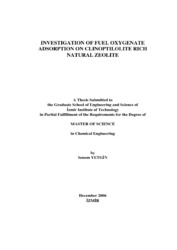Please use this identifier to cite or link to this item:
https://hdl.handle.net/11147/3738| Title: | Investigation of Fuel Oxygenate Adsorption on Clinoptilolite Rich Natural Zeolite | Authors: | Yetgin, Senem | Advisors: | İnal, Fikret | Publisher: | Izmir Institute of Technology | Abstract: | The wide use of fuel oxygenates in gasoline as anti-knocking and emission reduction agent have recently led to serious environmental concerns due to their detection in groundwater and surface water. Among the various gasoline additives, methyl tertiary butyl ether (MTBE) and ethyl tertiary butyl ether (ETBE) are the most frequently used fuel oxygenates worldwide. Due to the physical and chemical properties of fuel oxygenates, the conventional treatment technologies are generally ineffective for their removal from contaminated water. Adsorption is a common process frequently used to remove fuel oxygenates from water. The use of natural zeolites as adsorbent have increased significantly because of their availability and low cost. Clinoptilolite is one of the most abundant zeolites in nature, and Turkey has very large clinoptilolite reserves. In this project the adsorption properties of clinoptilolite rich natural zeolites for use in the removal of MTBE and ETBE from water have been investigated using batch equilibrium and fixed-bed column experiments. The adsorption properties have been compared with those of two activated carbons (i.e., Powdered Activated Carbon (PAC) and Granulated Activated Carbon (GAC)). In addition, bisolute (i.e., benzene and oxygenate) adsorption experiments were also carried out to determine the effectiveness of these adsorbents in the presence of other gasoline hydrocarbons. All the experiments were performed at 25 °C with initial oxygenate and benzene concentrations of 2000 ppb and 400 ppb, respectively. In batch equilibrium experiments, it has been found that the powdered and granulated activated carbons had higher adsorption capacities for MTBE and ETBE than clinoptilolite. The highest capacity for the amount of MTBE adsorbed per unit mass of adsorbent was achieved using GAC while that of ETBE was obtained using PAC. The presence of benzene decreased the adsorption capacities of GAC and PAC. However, the effect of benzene was not clear and was dependent on the adsorbent loading for clinoptilolite. In fixed-bed column experiments, GAC and clinoptilolite were tested as adsorbents. The column breakthrough curves for clinoptilolite were steep indicating fast adsorption and narrow mass transfer region. For GAC, mass transfer regions were wider due to the relatively flat breakthrough curves. There was no significant effect of benzene on the breakthrough curves for GAC and clinoptilolite. | Description: | Thesis (Master)--Izmir Institute of Technology, Chemical Engineering, Izmir, 2006 Includes bibliographical references (leaves: 78-83) Text in English; Abstract: Turkish and English xi, 83 leaves |
URI: | http://hdl.handle.net/11147/3738 |
| Appears in Collections: | Master Degree / Yüksek Lisans Tezleri Sürdürülebilir Yeşil Kampüs Koleksiyonu / Sustainable Green Campus Collection |
Files in This Item:
| File | Description | Size | Format | |
|---|---|---|---|---|
| T000582.pdf | MasterThesis | 2 MB | Adobe PDF |  View/Open |
CORE Recommender
Page view(s)
354
checked on Jun 16, 2025
Download(s)
194
checked on Jun 16, 2025
Google ScholarTM
Check
Items in GCRIS Repository are protected by copyright, with all rights reserved, unless otherwise indicated.